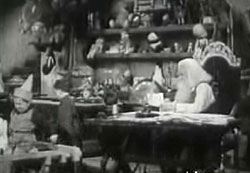 Produced by educational short subject company Sterling Films for grade-schools & the home-projection market, Merry Christmas (1950) opens on a lovely wintery scene & a snow-covered cottage.
Produced by educational short subject company Sterling Films for grade-schools & the home-projection market, Merry Christmas (1950) opens on a lovely wintery scene & a snow-covered cottage.
This is the North Pole & as the camera zooms in the icy window, we see Santa & his elves in the workshop making toys.
A totally unnecessary stentorial narrator gives a generic lecture on how neat Christmas is, but what matters here is the great live-action set-up of Santa's workshop, which is really a lovely thing, & Santa less freakishly creepy than usually portrayed. He's just a nice old white-bearded gent for a change.
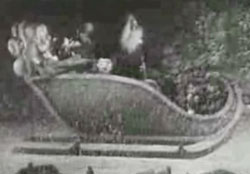 His three elves, played by kids, are Peppy, Zippo, & Click. They work at making & testing/playing with toys as Santa reads the letters he's received from children 'round the world. His three elves, played by kids, are Peppy, Zippo, & Click. They work at making & testing/playing with toys as Santa reads the letters he's received from children 'round the world.
On the night before Christmas he says goodbye to his helpers & hefts his bag of toys to set out. The scene jump-cuts to a nuclear family -- daddy, mommy, teenage girl, little girl, little boy -- decorating their Christmas tree.
Dad sits at a piano & his elder daughter begins to sing "Oh Come All Ye Faithful" then there's a jump-cut to a boys' choir (very likely the Vienna Boys' Choir) singing the same song, then back to the nuclear family.
Martha finishes the song & mom tells her it was lovely & they all head off to bed. Santa meanwhile is flying above the village in his sleigh.
Lorna, the littler girl, sneaks out of bed to replace her small christmas stocking with a huge one, then slips back to bed. Santa lands on the roof & pops down the chimney, empties out his bag, then pops back up the chimney. The young kids hurry to collect their toys at dawn. It concludes with pleasant living christmas card imagery & good wishes.
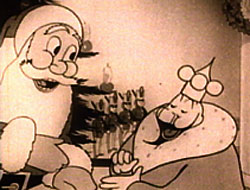 A "Little King" holiday cartoon, based on the comic strip character by Oscar G. Soglow, Christmas Night (1943) shows the Little King in his palanquin drawn by skaters.
A "Little King" holiday cartoon, based on the comic strip character by Oscar G. Soglow, Christmas Night (1943) shows the Little King in his palanquin drawn by skaters.
From his vantage-point he sees the villagers' holiday preparations & climbs down from his seat to join two tramps in pressing their collective noses against the toystore window.
A race-stereotype puppet dances in the window. The Little King goes inside to see Santa, & requests in writing (the Little King is a mute) a lot of toys. He then takes his two tramp buddies back to the palace & sneaks them inside under his robe.
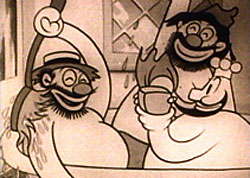 The tramps are excited by the new digs. Everyone gets naked, bathes, & puts on longjohns in preparation for bedtime, for the next morning will be Christmas. The tramps are excited by the new digs. Everyone gets naked, bathes, & puts on longjohns in preparation for bedtime, for the next morning will be Christmas.
First they nail their stockings over the fireplace, but the tramps' socks fall to pieces. So the Little King sneaks into the Big Queen's room & swipes her enormous fat-lady socks for his buddies.
They pile into bed together. Rising early enough to see Santa show up, they watch him create a magic Christmas tree & load up its underside with toys. The tramps & the Little King are so thrilled they begin playing with the toys like little kids, breaking things at once.
All the Little King cartoons are mediocre to bad, & this one's par for the course. And surely the Little King could afford to buy his own gawdamn toys.
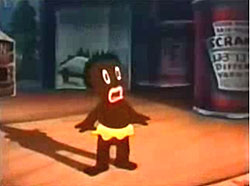 The Warner Brothers Merrie Melodies cartoon Goofy Groceries (1941) was suppressed in a more sensitive era for including blackface musical routines. When it did get shown, the offending scenes were frequently censored with destructive deletions.
The Warner Brothers Merrie Melodies cartoon Goofy Groceries (1941) was suppressed in a more sensitive era for including blackface musical routines. When it did get shown, the offending scenes were frequently censored with destructive deletions.
It opens on a beautiful snowy Christmassy street scene with shops closed for the holiday. Turning it into a Christmas cartoon seems to have been an afterthought, since once we're in the store that comes to life at night, there are no further elements of the holiday.
Inside a grocery store, we see the cow on a can of condensed milk singing, quite well, a jazz ballad, "If I Could Be with You." This is the voice of Bea Benaderet, who was also the voice of Betty Rubble on The Flintstones, & doomed always to be best remembered for her starring stint on the hillbilly comedy series Petticoat Junction.
The camera scans to an advertisement for Fulla Bull Tobacco, with a mighty bull listening to the cow's song. The crab on the label of the canned crab (with the impersonated voice of character actor Ned Sparks) says, "This love stuff makes me sick." A chicken pie in a pie case clucks.
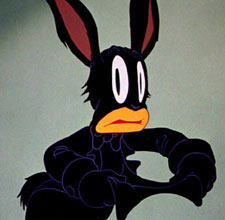 Numerous sight-gags enrich this appealing cartoon as all the products in the store convey their personalities & talents. A dog off a dogfood bag is master of ceremonies for a series of delightful acts. The Tomato Can Can Dance is performed by sexy cans of tomatoes singing "I'm Just Wild About Harry." Numerous sight-gags enrich this appealing cartoon as all the products in the store convey their personalities & talents. A dog off a dogfood bag is master of ceremonies for a series of delightful acts. The Tomato Can Can Dance is performed by sexy cans of tomatoes singing "I'm Just Wild About Harry."
Meanwhile in a dark corner of the store, a scary ape breaks out of a box of animal crackers. He goes on a rampage King Kong style, with all the entertainers fleeing through the store. Suddenly a little black boy who lives in the Log Cabin syrub can shows particular terror. Jack Bunny, a box of navy beans, even the turtles off cans of turtle soup & newly hatched chicks in sailor caps are braver than a black boy.
Just think of the black children in the segregated balcony with their families in the 1940s, bashed in the brains with cartoons like this! It's by no means exceptional. For a whole slug of films marred by "incidental" racism, start with Animated Stereotypes Part I.
Soon all out warfare has broken out against the ape, a reflection of World War II. Superman leaps off the label of a box of Superguy Chips, but turns into a crying baby at sight of the ape.
However, a woman's voice (in imitation of the radio program Henry Aldrich) cries out "Henry! Henry!" & the rampaging ape says, "Coming mother," & goes obediently home. Jack Bunny is left holding a firecracker which turns him into a blackface bunny who talks like Rochester.
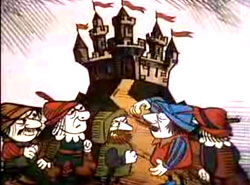 A Canadian pop group clumsily called The Original Caste (inducing many to wonder in what they were the original cast), with lead singer Dixie Lee Stone, was first to sing "One Tin Soldier" written by Dennis Lambert & Brian Potter, & released in 1969.
A Canadian pop group clumsily called The Original Caste (inducing many to wonder in what they were the original cast), with lead singer Dixie Lee Stone, was first to sing "One Tin Soldier" written by Dennis Lambert & Brian Potter, & released in 1969.
It immediately became a peace anthem of the 1970s & was quickly covered by any number of other singers & bands, though no version I've ever heard ever one-upped the original, despite that they turned out to be one-hit wonders.
The group Coven re-recorded it very well, however, in 1971, for the soundtrack of the movie Billy Jack (1972). It made Coven the second one-hit-wonder with the same song. Coven's lead vocalist was Jinx Dawson. Her version afterward became the soundtrack to the three-minute short of the same name One Tin Soldier (1973), by Australian animator John Wilson, who had worked for Walt Disney on Peter Pan (1953) and Lady & the Tramp (1955).
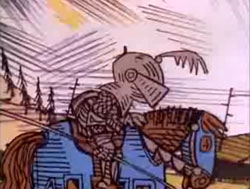 The style of the animation is a bit like Fractured Fairy Tales (1959-1961) but with no imposition of irony, merely conveying the story the lyrics tell, of misguided warfare. The style of the animation is a bit like Fractured Fairy Tales (1959-1961) but with no imposition of irony, merely conveying the story the lyrics tell, of misguided warfare.
Or, actually, Fractured Fairy Tales was better; the style of One Tin Soldier is too close to Mr. Magoo but with fairy tale happenings.
A shorter version of this cartoon preceded the final version, as CBS initially commissioned it for the Sonny & Cher Comedy Hour Christmas Special, 20 December 1972. Cher sings the anti-war song on the shorter version's soundtrack, & appears before the cartoon singing a Christmas carol as lead-in. Then she & Sonny appear immediately after for more Jesus celebrating.
Sonny & Cher totally kitched it up while making it a Jesus thing when the lyrics are quite clear that religion has been part of the problem. "Do it in the name of Heaven/ You can justify it in the end/ There won't be any trumpets blowing come the judgement day/ On the bloody morning after, one tin soldier rides away."
An unofficial version on youtube replaces the soundtrack by Coven with the same song by The Original Caste, losing a few sound FX in the process, & removing the end-credits.
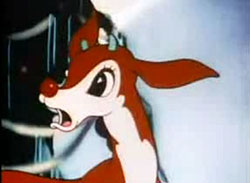 From Jam Handy Corporation which usually did educational & industrial film company, but unexpectedly directed by animation giant Max Fleischer, Rudolph the Red-Nosed Reindeer (1944 -- the date is often mistaken given as 1948, 1953, or ), in Technicolor, uses the famed song in a choral arrangement, though in 1944 the song wasn't yet well known.
From Jam Handy Corporation which usually did educational & industrial film company, but unexpectedly directed by animation giant Max Fleischer, Rudolph the Red-Nosed Reindeer (1944 -- the date is often mistaken given as 1948, 1953, or ), in Technicolor, uses the famed song in a choral arrangement, though in 1944 the song wasn't yet well known.
This was Rudolph's first animated appearance. Many have forgotten that Rudolph pre-dates the famous song, & was originally a Montgomery Ward advertising figure created by Robert L. May in 1939.
Johnny Marks wrote the story & later the song which was at first only used commercially, & not officially published & professionally recorded until 1949, when Gene Autrey recorded it in its final lyric form & reached Number One on the Billboard list for January 1950, six years after it was circulated in this cartoon. The sheet music published in 1949 featured a color cover based on the 1944 cartoon.
A few more years would pass before Rudolph became the protagonist of a Little Golden Book Rudolph the Red Nosed Reindeer (1958) by Barbara Shook Hazen was published, following the story pretty much as in the cartoon, & Richard Scarry's illustrations were based on the cartoon. D.C. Comics, however, had been issuing comic book Rudolph Annuals since 1950.
So the importance of the 1944 cartoon is central in launching Rudolph into the international consciousness of children. As the tale opens, adolescent reindeer are playing outside in the snow, just like children. Rudolph sneezes with a cold, & the reindeer begin to make fun of his red nose. A narrator tells us everything that is happening so that even three year olds will understand.
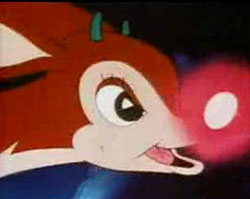 Rudolph lives with his pretty mommy in a nice house. Mommy tells him to hang his stocking before climbing into his bed on Christmas eve. He tosses under the covers, remembering how he was teased for having a red nose. Rudolph lives with his pretty mommy in a nice house. Mommy tells him to hang his stocking before climbing into his bed on Christmas eve. He tosses under the covers, remembering how he was teased for having a red nose.
Meanwhile up at the North Pole, good old Santa, speaking in a manly baritone, is preparing for his night of deliveries. Unfortunately it's awfully foggy out. The journey is unusually dangerous because of poor visibility; Santa's reindeer are forced to fly close to the ground, & crash into a tree. So they fly a little higher, & nearly get struck by a plain.
They make it to Reindeer Town & the home of Rudolph, where Santa see's the brightly glowing red nose. Santa had a great idea. He wakes Rudolph & says "I need you tonight! To lead all our deer on the rest of our flight!"
Rudolph leaves a note for his mom & joins Santa, insuring the rest of the journey is perfectly safe. And the next day, Rudolph is celebrated throughout Reindeer Town, & Santa gives him a gold medal. Nothing really special, but little kids'll love it.
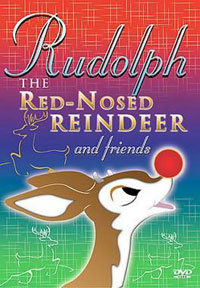 The 1944 Rudolph film is available on a number of Christmas compilation dvds, including Rudolph & Friends with several other vintage Christmas shorts, the oldest being Santa Claus (1899), the rest from the '30s & '40s including another Max Fleischer classic, Christmas Comes but Once a Year (1936); plus Somewhere in Dreamland (1936), Jack Frost (1934), Hector's Hectic Life (1948), & Snow Foolin' (1949). The same selection is also available as A Very Classic Christmas.
The 1944 Rudolph film is available on a number of Christmas compilation dvds, including Rudolph & Friends with several other vintage Christmas shorts, the oldest being Santa Claus (1899), the rest from the '30s & '40s including another Max Fleischer classic, Christmas Comes but Once a Year (1936); plus Somewhere in Dreamland (1936), Jack Frost (1934), Hector's Hectic Life (1948), & Snow Foolin' (1949). The same selection is also available as A Very Classic Christmas.
A very different selection also distributed as Rudolph & Friends but alternately as Christmas Cartoon Classics & other packaging titles. It has an even dozen cartoons, the Fleischer Rudolph plus eleven others only some of which are the same as listed in the previous paragraph. This recycling of the same package title with different content proliferates, & I will note only a few of the versions.
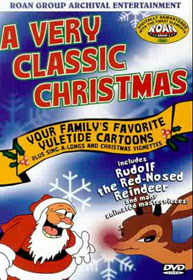 A two-dvd compilation similarly calledRudolph the Red-Nosed Reindeer & Friends includes a great deal of material. A two-dvd compilation similarly calledRudolph the Red-Nosed Reindeer & Friends includes a great deal of material.
The first disc includes the Max Fleischer classic, plus: Santa's Surprise (1947), Christmas Comes but Once a Year (1936), Ginger Nutts' Chrismas Circus (1949), The Shanty Where Santy Claus Lives (1933), The Pups' Christmas (1936), Snow Foolin' (1949) Gift Wrapped (1952), Christmas Visitor (1959), & Little Tin Soldier (Le Petit soldat, 1947).
The second disc extends the selection with Merry Christmas (1949), A Christmas Fantasy (1950), Madeline's Christmas (1951), Hector's Hectic Life (1948), Christmas Toy Shop (1945), Big Man from the North (1930), & Red-Headed Baby (1931). But this duo-disc collection, in circulation since 1994, is also sold, with the same title, in one-disc selections, so again, always check content.
As public domain material these get re-issued regularly with shifting but heavily overlapping content though having the same packaging titles. If you stumble on any one of these dirt-cheap in a cut-out bin, check the contents carefully.
Though almost always starting off with Fleischer's Rudolph classic, the rest of the content could have too much content dropped, so look for selections with the most. As a generality the cartoons from the '30s & '40s are best, so selections with the least post-1940s will be choicest. Many can also be downloaded for free from archive.org.
copyright © by Paghat the Ratgirl
|
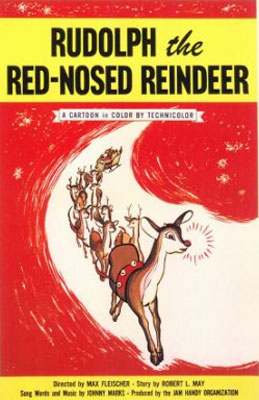

 His three elves, played by kids, are Peppy, Zippo, & Click. They work at making & testing/playing with toys as Santa reads the letters he's received from children 'round the world.
His three elves, played by kids, are Peppy, Zippo, & Click. They work at making & testing/playing with toys as Santa reads the letters he's received from children 'round the world.
 The tramps are excited by the new digs. Everyone gets naked, bathes, & puts on longjohns in preparation for bedtime, for the next morning will be Christmas.
The tramps are excited by the new digs. Everyone gets naked, bathes, & puts on longjohns in preparation for bedtime, for the next morning will be Christmas.
 Numerous sight-gags enrich this appealing cartoon as all the products in the store convey their personalities & talents. A dog off a dogfood bag is master of ceremonies for a series of delightful acts. The Tomato Can Can Dance is performed by sexy cans of tomatoes singing "I'm Just Wild About Harry."
Numerous sight-gags enrich this appealing cartoon as all the products in the store convey their personalities & talents. A dog off a dogfood bag is master of ceremonies for a series of delightful acts. The Tomato Can Can Dance is performed by sexy cans of tomatoes singing "I'm Just Wild About Harry."
 The style of the animation is a bit like Fractured Fairy Tales (1959-1961) but with no imposition of irony, merely conveying the story the lyrics tell, of misguided warfare.
The style of the animation is a bit like Fractured Fairy Tales (1959-1961) but with no imposition of irony, merely conveying the story the lyrics tell, of misguided warfare.
 Rudolph lives with his pretty mommy in a nice house. Mommy tells him to hang his stocking before climbing into his bed on Christmas eve. He tosses under the covers, remembering how he was teased for having a red nose.
Rudolph lives with his pretty mommy in a nice house. Mommy tells him to hang his stocking before climbing into his bed on Christmas eve. He tosses under the covers, remembering how he was teased for having a red nose.
 A two-dvd compilation similarly calledRudolph the Red-Nosed Reindeer & Friends includes a great deal of material.
A two-dvd compilation similarly calledRudolph the Red-Nosed Reindeer & Friends includes a great deal of material.